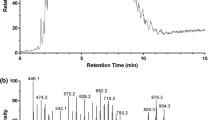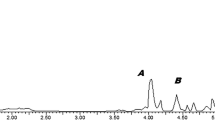Abstract
The temporal glands, modified facial apocrine sweat glands unique to elephants, release collectable secretions during an unusual physiological state termed “musth” in the Asian bull elephant (Elephas maximus). Recently we began the characterization of the chemical components of musth, especially in the temporal gland secretions (TGS), and the examination of the role of such secretions as agents for chemical communication between elephants. The present study focuses on possible correlations between testosterone levels in the serum and temporal gland secretions. We were especially interested in possible qualitative and/or quantitative changes in volatile compounds as the testosterone levels varied during a discrete musth period. Quantitative changes in TGS and serum testosterone were determined by radioimmunoassay. Qualitative and semiquantitative changes occurring in volatile composition were studied by high-resolution gas chromatography (fused silica capillary column, on column injection). Compound identification was by nuclear magnetic resonance, gas chromatography-mass spectrometry, and gas chromatography internal standards. Twenty-three major compounds and a number of minor components were identified. Androgen concentrations were correlated with TGS-specific volatiles including benzoic acid, 2-nonanone, 5-nonanol, tetradecanoic acid, and decanoic acid. The latter two compounds and (E)-farnesol, a major component of African TGS, demonstrated an inverse relationship to T levels.
Similar content being viewed by others
References
Bernard, R.T.F. 1986. Seasonal changes in plasma testosterone concentrations and Leydig cell and accessory gland activity in the Cape horseshoe bat (Rhinolophus capensis).J. Reprod. Fert. 78:413–422.
Boyer, A., Jemiolo, B., Andreolini, F., Wiesler, D., andNovotny, D. 1989. Urinary volatile profiles of pine voleMicrotus pinetorum, and their endocrine dependency.J. Chem. Ecol. 15:649–661.
Buss, I.O., Rasmussen, L.E., andSmuts, G.L. 1976. Role of stress and individual recognition in the function of the African elephants' temporal gland.Mammalia 40(3):437–451.
Drickamer, L.C., McIntosh, T.K., andRose, E.A. 1978. Effects of ovariectomy on the presence of a maturation-delaying pheromone in the urine of female house mice.Horm. Behav. 11:131–137.
Duvall, D., Schmitt, C.V., Erpino, M.J., andRabedeau, R.G. 1978. Androgen and concurrent androgen-progesterone maintenance of attack-eliciting characteristics of male mouse urine.Behavioral Biol. 22:343–353.
Estes, J.A., andBuss, I.O. 1976. Microanatomical structure and development of the African elephants' temporal gland.Mammalia 40(3):429–436.
Fernando, S.D.A., Jayasinghe, J.B., andPanabokke, R.G. 1963. A study of the temporal gland of an Asiatic elephant,Elephas maximus.Ceylon Vet. J. 11:108–112.
Fiorelli, G., Borrelli, D., Forti, G., Gonnelli, P., Pazzagli, M., andSerio, M. 1976. Simultaneous determination of androstenedione, testosterone and 5-alpha-dihydrotestosterone in human spermatic and peripheral venous plasma.J. Steroid Biochem. 7:113–116.
Folman, Y., Haltmeyer, G.C., andEik-Nes, K.B. 1972. Production and secretion of 5-alpha-dihydrotestosterone by the dog testis.Am. J. Physiol. 222:653–656.
Hess, D.L., Schmidt, A.M., andSchmidt, M.J. 1983. Reproductive cycle of the Asian elephant (Elephas maximus) in captivity.Biol. Reprod. 28:767–773.
Jainudeen, M.R., McKay, G.M., andEisenberg, J.F. 1972a. Observations on musth in the domesticated Asiatic elephant,Elephas maximus.Mammalia 36:248–261.
Jainudeen, M.R., Katongole, C.B., andShort, R.V. 1972b. Plasma testosterone levels in relation to musth and sexual activity in the male Asiatic elephant,Elephas maximus.J. Reprod. Fert. 29:99–103.
Maurel, D., Laurent, A.M., andBoissin, J. 1981. Short-term variations of plasma concentrations in the European badger (Meles meles). J. Reprod. Fert. 61:53–58.
Parrott, R.F., Booth, W.D., andBaldwin, B.A. 1985. Aggression during sexual encounters between hormone-treated gonadectomized pigs in the presence and absence of pheromones.Aggressive Behav. 11(3):245–253.
Rasmussen, L.E., Buss, I.O., Hess, D.L., andSchmidt, M.J. 1984. Testosterone and dihydrotestosterone concentrations in elephant serum and temporal gland secretions.Biol. Reprod. 30:352–362.
Rasmussen, L.E., Schmidt, M.J., andDaves, G.D. 1986. Chemical communication among Asian elephants, pp. 627–645,in D. Duvall, D. Muller-Schwarze, and R. Silverstein (eds.). Chemical Signals in Vertebrates IV. Plenum, New York.
Rasmussen, L.E.L. 1988. Chemosensory responses in two species of elephants to constituents of temporal gland secretion and musth urine.J. Chem. Ecol. 14:1687–1711.
Resko, J.A., Malley, A., Begley, D., andHess, D.L. 1973. Radioimmunoassay of testosterone during fetal development of the rhesus monkey.Endocrinology 93:156–161.
Resko, J.A., Ellinwood, W.E., Paszter, L.M., andA.E. Buhl 1980. Sex steroids in the umbilical circulation of fetal rhesus monkeys from the time of gonadal differentiation.J. Clin. Endocrinol. Metab. 50:900–907.
Rieger, D., andMurphy, B. 1977. Episodic fluctuation in plasma testosterone and dihydrotestosterone in male ferrets during the breeding season.J. Reprod. Fert. 51:511–514.
Schmidt, M.J. 1978. Elephants, pp. 709–752,in M.E. Fowler (ed.). Zoo and Wild Animal Medicine. W.B. Saunders, Philadelphia, Pennsylvania.
Schmidt, M.J. 1989. The fine art of elephant breeding.Anim. Kingdom 92(5):44–51.
Tremblay, R.R., Forest, M.G., Shalf, J., Martin, J.G., Kowarski, A., andMigeon, C.J. 1972. Studies of the dynamics of plasma androgens and on the origin of dihydrotestosterone in dogs.Endocrinology 91:556–561.
Wheeler, J.W., Rasmussen, L.E., Ayorinde, F., Buss, I.O., andSmuts, G.L. 1982. Constituents of temporal gland secretions of the African elephantLoxodonta africana.J. Chem. Ecol. 8:821–835.
Author information
Authors and Affiliations
Rights and permissions
About this article
Cite this article
Rasmussen, L.E.L., Hess, D.L. & Haight, J.D. Chemical analysis of temporal gland secretions collected from an Asian bull elephant during a four-month musth episode. J Chem Ecol 16, 2167–2181 (1990). https://doi.org/10.1007/BF01026928
Received:
Accepted:
Issue Date:
DOI: https://doi.org/10.1007/BF01026928




